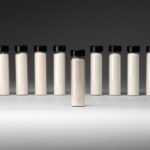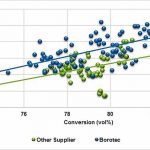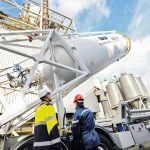To improve refinery margins there is a trend towards processing heavier, more contaminated crude oil. Thus, fluid catalytic cracking (FCC) feedstock is likewise getting heavier. One of the contaminants is nickel (Ni). Nickel forms deposits on the FCC catalyst and catalyses dehydrogenation reactions, which increase unwanted hydrogen and contaminant coke production. These are low value products which diminish the profitability of the FCC unit. Strong demand therefore exists for improved Ni passivation technology. Nickel passivation is especially beneficial when the FCC unit operates at the wet gas compressor (WGC) limit. By removing the WGC limit, a substantial increase in profitability is immediately possible by increasing either the FCC unit throughput or the operating severity. The effect of nickel can be reduced using passivators such as antimony or speciality alumina – or, more recently, Boron Based Technology.
Prior art of passivation technologies
Nickel passivation using antimony (Sb) compounds was first patented by Phillips Petroleum Co. (US 3711422 patent, Johnson M.M., Tabler D.C.) and has been in use now for more than 40 years. Sb based Ni passivator chemicals are injected into the feed. According to FCC unit benchmarking, Sb injection alone can reduce the dehydrogenation effect of Ni by 20 to 40%. After injection, there is typically an immediate, sharp reduction in dry gas production and delta coke. However, apart from passivating Ni, Sb can also poison carbon monoxide (CO) combustion promoters and increase nitrogen oxide (NOx) emissions. In addition, there are environmental and safe handling considerations. Antimony’s use is not permitted in all FCC units for this reason. Furthermore, depending on several factors, the antimony pick-up by the FCC catalyst can vary, impacting the effectiveness of this Ni passivation option.
As an alternative to this method, specialty aluminas are commonly used in resid-FCC catalysts for trapping Ni by keeping it in a higher oxidation state, thus reducing overall hydrogen and contaminant coke production. The efficacy of this route is limited by the very low mobility of Ni and the immobile nature of the alumina trap. It is known that Ni deposition on resid-FCC catalysts typically follows a gradient, where higher amounts of Ni accumulate on the outer surfaces of the catalyst particle. Using the peripheral deposition index (PDI) to quantify this observation, it was revealed that the PDI values measured for Ni are generally high, confirming its extremely limited mobility. Since Ni tends to be concentrated on the peripheral surfaces of a resid-FCC catalyst, it can only be trapped by alumina when it is within sufficient proximity. It can be concluded that the lack of both alumina trap and Ni mobility within the catalyst particle limits alumina’s ability to passivate Ni. Therefore, BASF’s goal was to develop the next generation of Ni passivation technology.
Boron Based Technology
The solution was a boron based chemistry to passivate Ni, which is uniquely used in BASF’s Boron Based Technology (BBT) platform. BASF studied the boron chemistry to evaluate the Ni passivation mechanism. Multiple spectroscopic studies show that by using Boron Based Technology, Ni can be kept in a more electron deficient (i.e. less reducible) state, which inhibits its potential to participate in dehydrogenation reactions, thus lowering the formation of hydrogen and contaminant coke. In addition, BBT offers several benefits compared to the prior art. Unlike antimony, boron does not increase NOx emissions in the FCC. In addition, boron is mobile under FCC conditions; its efficacy in Ni passivation is therefore greater than that of specialty alumina, as it migrates within the catalyst to passivate Ni.
Solutions for refiners
In 2016, BASF introduced Borocat to the market – the first FCC catalyst based on its BBT platform. Since then, Borocat has been successfully implemented in refineries all over the world. Results have shown that refineries using Borocat can process heavier, more contaminated feedstocks and hence improve their profitability. Refiners impressed with the success of Borocat asked BASF to propose a catalyst suitable for variable quality or for mild to moderate-resid feedstocks. The Borotec FCC catalyst was the solution. Launched in 2017, Borotec is BASF’s latest innovation from its BBT platform.
At a refinery which processes a mild-resid feedstock, Borotec was benchmarked against other suppliers’ premium bottoms upgrading technologies. In the commercial trial, Borotec delivered good metals tolerance and improved liquid yields. Compared to the competitors’ catalysts, Borotec enabled the refinery to:
- Decrease hydrogen and contaminant coke yields
- Improve activity retention at similar vanadium and sodium levels
- Improve bottoms upgrading and liquid yields
- Improve propylene and butylene yields (after catalyst optimisation)
This successful commercial trial confirmed the ability of Borotec to improve performance, leading to higher yields of valuable products and lower bottom-of-the-barrel yields compared to competitor technologies. The optimised metals tolerance feature provided by Borotec allows improved crude flexibility for refiners, who increasingly engage in spot buying to maximise profits. The Borotec FCC catalyst was developed to offer them better operation and margins.
Online search: cppPC117basf
Catalyst trials : Portable system
BASF has introduced a portable fluid catalytic cracking (FCC) catalyst addition system for refineries. It allows them to conduct catalyst and co-catalyst trials while minimising the potential risks of changing to a new catalyst. The system is easy to use, requires only a small plot space and needs no special preparations to deliver reliable and precise additions. The truck with the portable loader arrives at the refinery, is put in position, raised upright, connected to the refiner unit and loaded with catalyst. All additions are controlled from the local panel and no civil work of any kind is necessary.
Authors : Carl Keeley Vasilis Komvokis Sabeeth Srikantharajah
Regional Marketing Manager,
BASF Refining Catalysts EMEA
Technology Manager,
BASF Refining Catalysts EMEA
Technical Account Manager,
BASF Refining Catalysts EMEA









